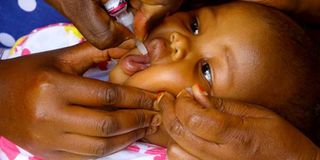Delivery at clinics reduces child deaths

Community health workers need to initiate door-to-door visits providing vitamins, supplements and above all, knowledge to expectant mothers especially those living in rural areas. PHOTO | FILE
What you need to know:
- However, a closer look at the numbers shows that nine out of 10 women visited the antenatal clinic only once during pregnancy, against the World Health Organisation (WHO) recommendation of four visits.
- The disparity across socio-economic status is also substantial. Three out of 10 births by women in the lowest wealth class got the recommended delivery assistance compared with nine out of 10 of those in the highest wealth level.
- She said that community health workers need to initiate door-to-door visits providing vitamins, supplements and above all, knowledge to expectant mothers especially those living in rural areas.
Increased visits to clinics by expectant and new mothers and increased use of mosquito nets by children has significantly reduced the infant mortality rate in Kenya.
The Kenya Demographic Health Survey (KDHS 2014) shows that the infant mortality rate has dropped from 52 deaths per 1000 live births in 2009, to 39 deaths per 1000 live births, citing increased proportions of births assisted by a skilled attendant and women delivering in health facilities.
Kenya recorded an impressive increase in the number of mothers attending antenatal care from 88 per cent in 2003 to 96 per cent in 2014. There was also a rise in the number of women receiving a post-natal check-up within two days after birth from one out of 10 in 2003, to four out of 10 in 2009 and five out of 10 in 2014.
Dr Agnes Gachoki a gynaecologist at Nairobi Hospital attributed these milestones to the introduction of free maternal healthcare and an increase in trained health professionals. She also noted that there are more ambulances in counties that are able to reach mothers in rural Kenya.
However, a closer look at the numbers shows that nine out of 10 women visited the antenatal clinic only once during pregnancy, against the World Health Organisation (WHO) recommendation of four visits. The percentage of women attending four or more ANC visits ranges from a low of 18 per cent in West Pokot to 73 per cent in Nairobi.
In a quarter of the counties, less than 50 per cent of pregnant women attended the recommended number of antenatal clinics.
The KDHS shows that geographic location, level of education, age and economic status of mothers determine the overall health of pregnant women and their babies before and after delivery.
COMMUNITY HEALTH
Looking at geographical location, only five in 10 of mothers in rural areas received skilled care or delivered in a health facility. In contrast, eight out of 10 of their urban counterparts delivered in a health facility assisted by a skilled attendant. Further, four out of 10 of women in rural Kenya received a post-natal check-up compared with six out of 10 women in urban areas.
Education and wealth also determine whether a woman visits a health clinic before and after birth. Before giving birth, 69 per cent of educated women visited a health facility at least four times for check-ups, while only 43 per cent of women with no education attended antenatal clinics.
Moreover, eight out of 10 women with secondary education or higher received skilled care during childbirth compared with four out of every 10 mothers with no education. In addition, six out of 10 women with secondary or higher education received post-natal care within two days of childbirth compared with two in 10 women with no education.
The disparity across socio-economic status is also substantial. Three out of 10 births by women in the lowest wealth class got the recommended delivery assistance compared with nine out of 10 of those in the highest wealth level. After delivery, three out of 10 women in the lowest wealth class received post-natal care compared with seven out of 10 mothers in the highest wealth class. According to Dr Gachoki, deployment of community health workers can close this gap between the wealthy and the poor.
“Most of those in the lower class will not attend clinics because of travel expenses. They only go to hospital when they are feeling sick,” she explained.
She said that community health workers need to initiate door-to-door visits providing vitamins, supplements and above all, knowledge to expectant mothers especially those living in rural areas.
Age also determines whether women attend antenatal and postnatal care clinics. Antenatal care is more common among women aged 20 to 34 years, of whom 98 per cent are in urban areas, while 94 per cent live in rural areas. On the other hand, women aged 35-49 years are less likely to receive post-natal care within two days of childbirth, compared to younger women.
“New mothers naturally have more questions and will therefore want to know what is going on at every stage as compared to experienced mothers,” Dr Gachoki said, explaining the discrepancy. She however added that the laxity by experienced mothers could pose a threat to newborns since conditions that are not visible to the naked eye can easily go undetected.


